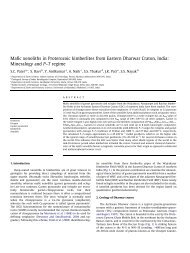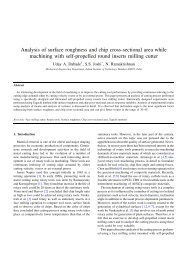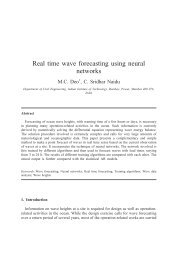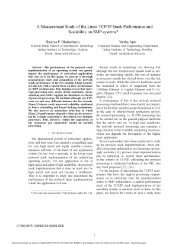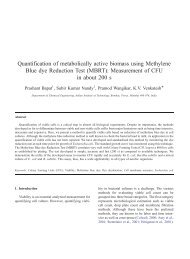Infrared signature studies of aerospace vehicles - DSpace at IIT ...
Infrared signature studies of aerospace vehicles - DSpace at IIT ...
Infrared signature studies of aerospace vehicles - DSpace at IIT ...
Create successful ePaper yourself
Turn your PDF publications into a flip-book with our unique Google optimized e-Paper software.
on the aircraft. When viewed from front and sides,<br />
the plume and airframe contribute; and when<br />
viewed from the rear, the engine hot parts become<br />
the major source <strong>of</strong> IR radi<strong>at</strong>ion. When viewed<br />
from the rear, a typical IR-guided SAM can achieve<br />
a lock-on from 4–6 km, because <strong>of</strong> the direct view <strong>of</strong><br />
hot engine parts <strong>at</strong> 600–7001 C [9]. The IR plot <strong>of</strong> a<br />
typical jet-engine-powered aircraft from various<br />
view angles is given in Fig. 2(a). In general, an<br />
aircraft with a jet engine has an IR radi<strong>at</strong>ion<br />
intensity in the range 100–1000 W/Sr, over several<br />
viewing aspects [13]. For the same thrust level,<br />
turbojets have larger IRSL than turb<strong>of</strong>ans, and<br />
Rel<strong>at</strong>ive Intensity<br />
1<br />
180°<br />
3-5 μm band<br />
135°<br />
ARTICLE IN PRESS<br />
turb<strong>of</strong>ans have larger IRSL than turboprops [13].In<br />
helicopters [Ref. Fig. 2(b)], the main contributors <strong>of</strong><br />
IR <strong>sign<strong>at</strong>ure</strong> are: (i) the engine exhaust duct, (ii) the<br />
direct view <strong>of</strong> engine hot parts like the turbine<br />
blades, (iii) the tail boom he<strong>at</strong>ed by exhaust plume,<br />
and (iv) the exhaust plume.<br />
3.2. IR detectors<br />
Over the years, significant developments have<br />
taken place in IR-detector technology [41], towards<br />
increasing their sensitivity [i.e. reducing their Noise<br />
Equivalent Irradiance (NEI)]. Current gener<strong>at</strong>ion<br />
0<br />
0<br />
2.4 3.2 4.0 4.8 2.4 3.2 4.0 4.8<br />
1<br />
0<br />
2.4 3.2 4.0 4.8<br />
30° 80°<br />
0°<br />
powerturbine<br />
tallpipe<br />
plumehe<strong>at</strong>ed<br />
tallboom<br />
λ (μm)<br />
90°<br />
270°<br />
45°<br />
225° 315°<br />
1<br />
4<br />
180°<br />
0<br />
overall<br />
helicopter<br />
exhaust<br />
plume<br />
2.4 3.2 4.0 4.8<br />
Fig. 2. IR <strong>sign<strong>at</strong>ure</strong> vari<strong>at</strong>ion <strong>of</strong> gas turbine engine-powered <strong>aerospace</strong> vehicle: (a) fixed wing aircraft (after [13]) and (b) rotary wing<br />
aircraft Bell UH-1H (after [3]).<br />
0°<br />
223



